Sketch update – April 28, 2007
I figured the binocular sketch I made of the comet and M13 a few months ago ought to be redrawn. It was done on plain laser printer paper, and which didn’t handle the shading very well. Below is the new sketch, created on Strathmore sketch paper at a size of about 8″ x 10″. The star field was traced from a chart produced by Starry Night Pro. I left the previous sketch further below for comparison.
Click above image for large version (350K)
Observation Notes
Realizing that the comet would brush M13 with its tail this evening, I set up my telescope in the back yard, got the binoculars and camera ready, and printed out a star chart of the area. I began with a binocular observation that showed the tail very faintly reaching up to barely brush past M13 on its west side. As it did the night before, I noticed a subtle blue-green glow to the coma. The sketch is shown below.
Move mouse over upper image for labels.
Next I went over to the telescope and was very pleased to see this comet was breathtaking with a little aperture put on it. The color of the coma was strongly greenish-cyan. At 37.5X, the coma seemed to sport a fan shaped dark region opposite the tail. The ion tail peeled away at a PA of about 35 degrees. The coma itself seemed to fade into a possible short dust tail at a PA of about 10 degrees. A stellar pseudo nucleus burned at the heart of the coma. A magnification of 240X still showed the greenish-cyan color, and with time, I saw what I thought were some spokes of brightness at varying positions. I still picked up what seemed to be a dark fan-shaped region in the anti-tail position. Sketches are shown below. I made the high-magnification sketch first. The structure in this high magnification view was very subtle, and may have been an illusion. Perhaps some detailed astrophotos that don’t over-expose the coma will help me determine how valid those observations were.
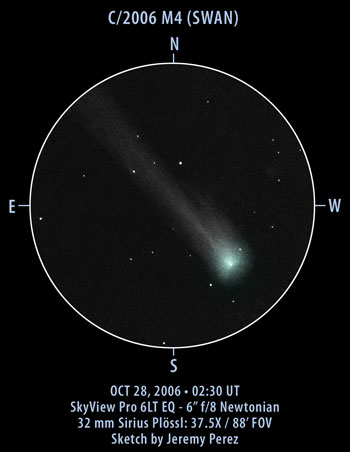
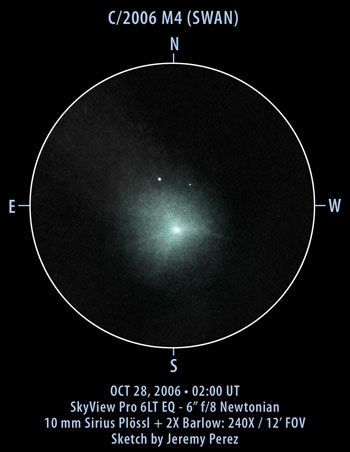
After working up the sketches, I decided to give some astro photos a try. The ion tail is faintly visible running to the west of M13, and proceeding for a couple degrees past it. The shorter dust tail is also visible exiting the north side of the coma. I’ve been having trouble processing the photos without overemphasizing the noise, so I’m posting rollover images below. Move your mouse over the image for a more brightly exposed image with labels as well.
Move mouse over upper image for labels.
Examining the color channels in the unedited images shows the coma to be strong in both the blue and green channels, while the tail is strong mainly in the blue channel only. After processing them, the blue color of the tail has dropped away, and means I’ll probably be revisiting these images again later.
Object Information:
| Subject | Comet 2006/M4 (SWAN) |
| Classification | Comet |
| Position* | Hercules: 01:50 UT – [RA: 16:29:55.4 / Dec: +33:52:05] 03:44 UT – [RA: 16:30:45.6 / Dec: +33:48:09] |
| Size | Coma: 10′ |
| Brightness | ~4.8 vMag |
| Date/Time | October 27, 2006 – 6:50 – 8:44 PM MST (October 28, 2006 – 01:50 – 03:44 UT) |
| Observing Loc. | Home – Flagstaff, AZ |
| Instrument | 10 x 50 Binoculars, Orion SkyView Pro 6LT – 6″ Newtonian |
| Eyepieces/Mag. | 32 mm, 10 mm + 2X Barlow |
| Conditions | Clear, calm |
| Seeing | 5/10 |
| Transparency | Mag 5.8 + NELM |
| *Sources | Starry Nights Pro Plus v. 5.8 |
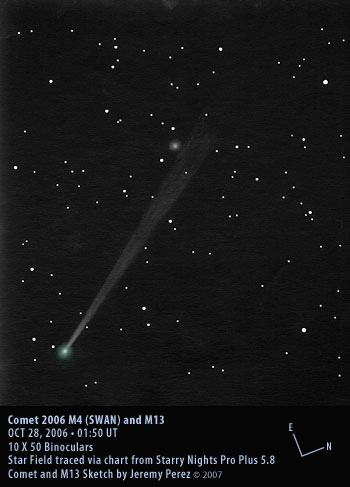
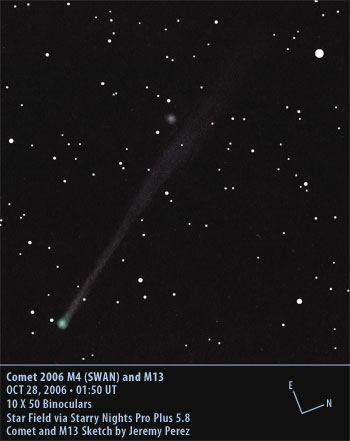
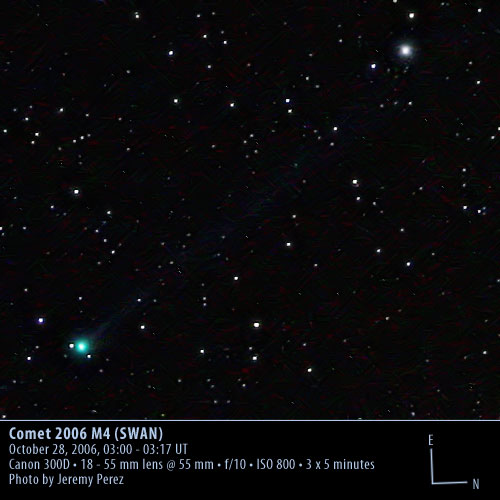
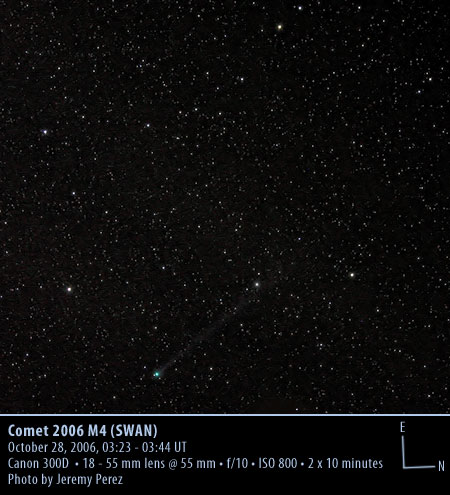
Those are some great shots.I tried to find the comet a few nights ago using bino’s.We had high clouds moving,which ruined any chance of seeing this comet for the first time.HAHAHAHAHA….actually,I was looking further to the west than I should have anyway!.When the wind dies down and the skies clear up.I will give it another try and maybe get some pix!.
Andrew
Thanks Andrew! I hope you have success locating and imaging it with some cooperative weather. I look forward to seeing the results.
Jeremy